CAA News Today
Natasha Hovey and Steve Hilton
posted by CAA — November 05, 2018
The weekly CAA Conversations Podcast continues the vibrant discussions initiated at our Annual Conference. Listen in each week as educators explore arts and pedagogy, tackling everything from the day-to-day grind to the big, universal questions of the field.
CAA podcasts are now on iTunes. Click here to subscribe.
This week, Natasha Hovey and Steve Hilton discuss a yearlong artist residency model at Midwestern State University.
Natasha Hovey is currently an assistant professor at Texas A&M International University in Laredo, Texas, where she teaches: Ceramics 1, Intermediate and Advanced Ceramics, Sculpture 1, Intermediate and Advanced Sculpture, and Practicum Course for Seniors. She never thought she would miss it, but she longs for the Midwest’s subzero temps and feet of snow.
Steve Hilton is a professor of art at the Lamar D. Fain College of Fine Arts at Midwestern State University in Wichita Falls, Texas, teaching both Ceramics and Art Education. He just found out that the current MSU ceramics resident has been offered a full-time position, which means the MSU residency program is 6 for 6 in placing residents.
Paul Catanese and Greg Pond
posted by CAA — October 29, 2018
The weekly CAA Conversations Podcast continues the vibrant discussions initiated at our Annual Conference. Listen in each week as educators explore arts and pedagogy, tackling everything from the day-to-day grind to the big, universal questions of the field.
CAA podcasts are now on iTunes. Click here to subscribe.
This week, Paul Catanese and Greg Pond discuss intermedia pedagogy and research.
Paul Catanese is an associate professor at Columbia College Chicago where he directs the graduate program for the Art and Art History Department; he’s been known to fly kites, launch rockets, pilot drones, and lately a blimp as part of his art practice.
Greg Pond is professor of art at Sewanee: The University of the South in Tennessee. Originally from Portland, Oregon, Pond is one of the founder’s of Nashville’s Fugitive Projects and a sculptor who incorporates sound, video, and digital media into his practice and also makes documentaries about social justice issues in inner city Kingston, Jamaica.
Member Spotlight: Pauline Chakmakjian, Visit Kyoto Ambassador
posted by CAA — October 25, 2018
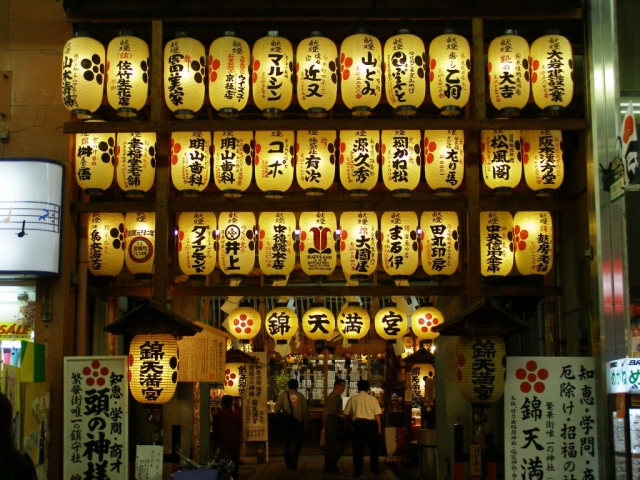
Lanterns lit in Teramachi Street, Kyoto. Photo: Pauline Chakmakjian, MA
Coming up in the spring of next year, we’re pleased to partner with Martin Randall Travel to offer a trip for scholars and artists to Japan. “Understanding Japan for CAA – Arts & Crafts, History, Religion & Traditions” will take place May 9-20, 2019, and will be led by independent Japan scholar and CAA lifetime member, Pauline Chakmakjian.
As a lifetime member and a specialist who lectures on a variety of subjects related to the history, fine arts, and culture of Japan, we wanted to highlight the work Pauline is doing in our Member Spotlight series. Read our interview with her below.
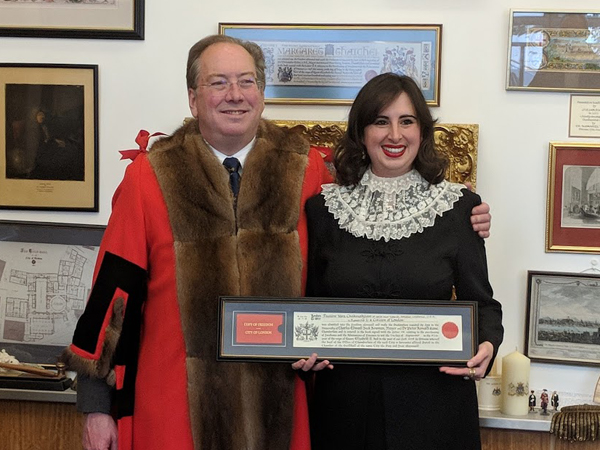
Pauline Chakmakjian, Freeman of the City of London, September 2018. Photo: Pauline Chakmakjian, MA
Joelle Te Paske: Hi Pauline. Thanks for taking the time to answer our questions. So to begin, where are you from originally?
Pauline Chakmakjian: I was born in Los Angeles, California.
JTP: What pathways led you to the work you do now?
PC: My primary passions are travel and the arts. The associations and networks I have developed throughout the years have naturally led to projects that combine this fondness for both cultural variety and the diversity of thought and creativity in various countries, especially Japan.
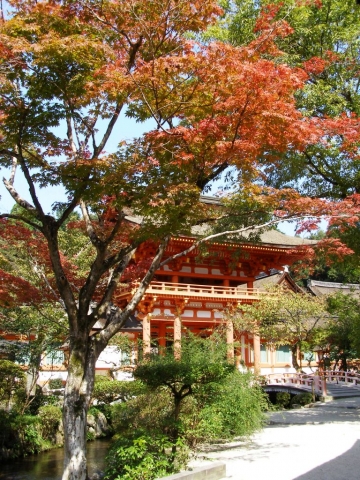
Temple in Kyoto. Photo: Pauline Chakmakjian, MA
JTP: When did you first become a CAA member?
PC: In the summer of 2015, in order to support art and art education.
JTP: Why are you a life member? What has that meant to you?
PC: I think in a long-term manner and carefully select organizations to support that reflect my own interests. With time, becoming a life member will increase in value for me personally, since CAA is focused on art and art makes life exceptionally rich and pleasant. My preference is to support things that encourage creativity and beauty—arts and culture are what makes us human.
JTP: Have you attended CAA conferences?
PC: I have not yet had the pleasure of attending a CAA conference due to my previous travel commitments, but certainly plan to in the future.
JTP: The upcoming tour—“Understanding Japan for CAA – Arts & Crafts, History, Religion & Traditions”—is specifically designed for CAA members. What are you most excited for?
PC: The Kyoto part of the trip, which is towards the end of the tour, of course! In so many ways, the old capital of Kyoto is the heart of Japan, from artistic and culinary traditions that are over one thousand years old, to the eternal backdrop of the tastes and pastimes of the nobility of the Heian-period court, which have cascaded down to influence generations of Japanese people ever since.
JTP: What is the most surprising thing for people to know about Japanese art history?
PC: There are many surprises for those who have never been to Japan or studied its artistic heritage, but if I had to choose one it would be that much of the traditional look or aesthetics of Japanese art are manifestations of the preferences of the upper tiers of the hierarchical class system the Heian court of one thousand years ago, borrowed from the ancient Imperial Chinese court in Chang’an (Xian). The upper two tiers consisted of the Emperor and his retinue of courtiers first, and then the warrior class. These two classes were largely responsible for the distinctive elements and emphases found in Japanese art, from landscape architecture to painting to teaware.
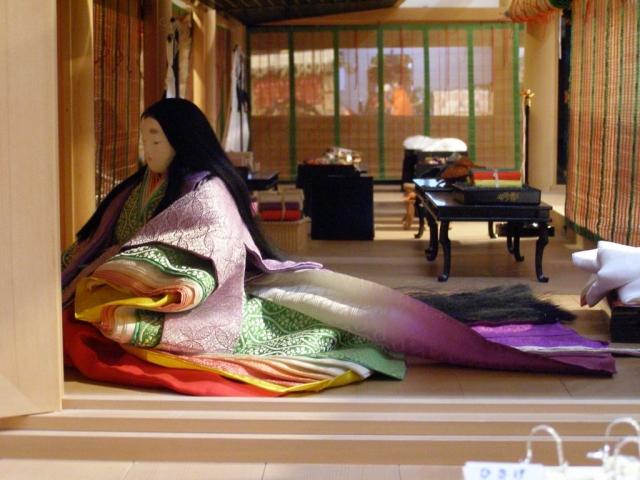
Doll of Lady Murasaki Shikibu, Kyoto. Photo: Pauline Chakmakjian, MA
JTP: Can you tell our members one unforgettable travel story?
PC: Yes, sailing to Easter Island was probably the most adventurous thing I’ve attempted travel-wise. From Tauranga to Hanga Roa I was on board a two-masted brigantine with a permanent and voyage crew for 33 days of sailing across the Pacific. I had always wanted to visit Easter Island and this travel journey combined this dream with my love of classical sailing ships. We were also given instruction on celestial navigation over the course of the sailing experience.
The image that stays in one’s mind and feeling of sailing through a gale force 8 storm at the helm is thrilling. I love paintings by Montague Dawson and this was like one of his paintings in motion.
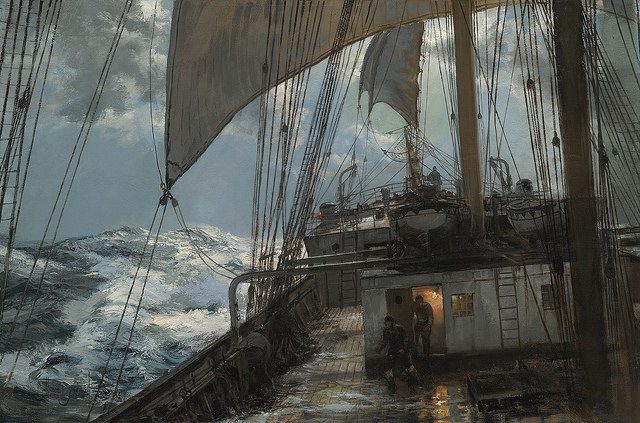
Montague Dawson, A Night at Sea, n.d. (Artwork in the public domain, via Flickr)
JTP: What advice would you give someone looking to partner with travel agencies and lead the sort of tours you do?
PC: A broad range of knowledge on the destination is essential. Though the focus is usually on the arts in terms of cultural travel companies, the tour leader will be asked about the other aspects of the country such as its politics, economy, technology, and other areas, so it’s not enough to simply know about fine art, music, and the performing arts.
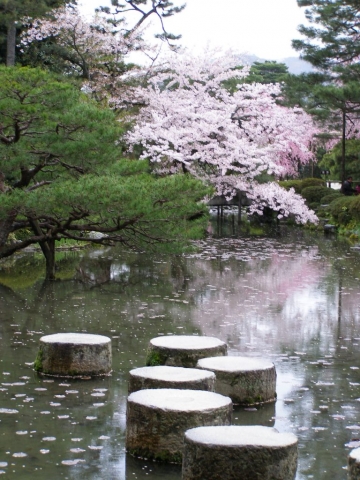
Heian Shrine, Kyoto. Photo: Pauline Chakmakjian, MA
JTP: What is your top recommendation (such as a book, website, or resource) for people working in the arts right now?
PC: There are so many resources both offline and online depending on one’s particular focus or interest in the arts, but I do quite like the international edition of The Art Newspaper. It’s particularly handy for people who travel a lot.
JTP: Do you have a favorite artist or artwork?
PC: This is difficult to answer as there are so many talented people who have created beauty of various types in this world, but the moment that made me want to lecture on art was during my undergraduate studies after I gave a talk for over an hour on The Garden of Earthly Delights by Hieronymous Bosch. This triptych is truly one of the most unique and extraordinary works of art ever made. The eccentricities within each section of the triptych as well as Bosch’s personal associations is what also partly made me curious about private, esoteric networks such as Freemasonry, which I also lecture on.
Pauline Chakmakjian is an independent lecturer on a variety of subjects related to the history, fine arts and culture of Japan. She lectures for private member societies, corporate entertainment, private homes, universities, cruises, charities and other related organizations including lecture tours in Australia and New Zealand. She holds a BA in English Literature during which she was also awarded a Merit Scholarship in Fine Art, a Diploma in Law, an MA in Modern French Studies and is a member of the Honourable Society of the Inner Temple. Pauline was elected onto the Board of the Japan Society of the United Kingdom from 2008–2014 and the Japan Society of Hawaii from 2015–2017. In 2014, Pauline was appointed a Visit Kyoto Ambassador by the Mayor of the City of Kyoto.
Elizabeth Guffey, Matt Ferranto, and Rebecca Mushtare
posted by CAA — October 22, 2018
The weekly CAA Conversations Podcast continues the vibrant discussions initiated at our Annual Conference. Listen in each week as educators explore arts and pedagogy, tackling everything from the day-to-day grind to the big, universal questions of the field.
CAA podcasts are now on iTunes. Click here to subscribe.
This week, Elizabeth Guffey, Matt Ferranto, and Rebecca Mushtare discuss “Bringing Access to Design Practice: Teaching Inclusion in the 21st Century.”
Elizabeth Guffey is Professor of Art & Design History, State University of New York at Purchase.
Matt Ferranto is Associate Professor of Design, Westchester Community College.
Rebecca Mushtare is Associate Professor of Graphic Design, State University of New York at Oswego.
Sarah Berkeley and Steve Snell
posted by CAA — October 15, 2018
The weekly CAA Conversations Podcast continues the vibrant discussions initiated at our Annual Conference. Listen in each week as educators explore arts and pedagogy, tackling everything from the day-to-day grind to the big, universal questions of the field.
CAA podcasts are now on iTunes. Click here to subscribe.
This week, Sarah Berkeley and Steve Snell discuss performance art.
Sarah Berkeley is an artist who works across media questioning cultural norms such as the 9:00 to 5:00 work day, the office environment, indoor living, gender stereotypes, and the voluntary sharing of personal data.
Steve Snell is an assistant professor in the Foundation Department at the Kansas City Art Institute whose work is inspired by American history, mythology, and the image (and experience) of adventure.
Martha Hollander and Tyler Rockey
posted by CAA — October 08, 2018
The weekly CAA Conversations Podcast continues the vibrant discussions initiated at our Annual Conference. Listen in each week as educators explore arts and pedagogy, tackling everything from the day-to-day grind to the big, universal questions of the field.
CAA podcasts are now on iTunes. Click here to subscribe.
This week, Martha Hollander and Tyler Rockey discuss web-based tools and approaches in the art history classroom.
Martha Hollander is a professor of art history at Hofstra University. Tyler Rockey is an adjunct professor of art history at Neumann University.
Janis Chakars and Martha Lucy
posted by CAA — October 01, 2018
The weekly CAA Conversations Podcast continues the vibrant discussions initiated at our Annual Conference. Listen in each week as educators explore arts and pedagogy, tackling everything from the day-to-day grind to the big, universal questions of the field.
CAA podcasts are now on iTunes. Click here to subscribe.
This week, Janis Chakars and Martha Lucy discuss art education in a visual society within the context of the Barnes Foundation.
Janis Chakars is associate professor of communication and digital media, Neumann University. Martha Lucy is deputy director for research, interpretation and education at the Barnes Foundation.
Amy K. Hamlin and Karen J. Leader
posted by CAA — September 25, 2018
The weekly CAA Conversations Podcast continues the vibrant discussions initiated at our Annual Conference. Listen in each week as educators explore arts and pedagogy, tackling everything from the day-to-day grind to the big, universal questions of the field.
CAA podcasts are now on iTunes. Click here to subscribe.
This week, Amy K. Hamlin and Karen J. Leader discuss Art History That, a project they launched in 2014 to curate, crowdsource, and collaborate on the future of art history.
Amy K. Hamlin is Associate Professor of Art History at St. Catherine University. Karen J. Leader is Associate Professor of Art History at Florida Atlantic University. They are the co-founders of Art History That, and are co-authoring the book Art History That: Initiatives for the Future of a Discipline.
Hunter O’Hanian in Conversation with Eric Segal, Director of Education and Curator of Academic Programs at the Harn Museum
posted by CAA — September 04, 2018
CAA’s executive director, Hunter O’Hanian, recently visited the Harn Museum of Art in Gainesville, Florida to speak with Eric Segal, the museum’s director of education and curator of academic programs, about the role of academic art museums and Resources for Academic Art Museum Professionals (RAAMP).
A project of CAA supported by the Andrew W. Mellon Foundation, RAAMP aims to strengthen the educational mission of academic museums and their parent organizations by providing a publicly accessible repository of resources, online forums, and relevant news and information.
Watch and read the interview below.
Hunter O’Hanian: Hello everybody. My name’s Hunter O’Hanian and I’m the director of the College Art Association. I’m very pleased today to be with Eric Segal, who is the director of education and curator of academic programs here at the Harn Museum in Gainesville, Florida. Hello, Eric. How are you?
Eric Segal: Hunter, I’m doing well. It’s great to have you here in Gainesville.
HO: Well, it’s absolutely beautiful. It’s been great to be spending time here and to go through the museum. Before we start, tell us a little bit about your background. I know you’ve been a CAA member since you were in graduate school, but tell us a little bit about your professional background.
ES: Sure. CAA since 1993.
HO: Yay.
ES: I actually started my college career as a computer engineering major. So, it was a big change when my sister made me take an art history class and that led me into art history, and I studied American art subsequently at UCLA, Masters.
HO: And, I think you won a Terra award, too.
ES: I was really fortunate to have a Terra award in 1999.
HO: Great.
ES: And that was very exciting for me and helped me in my studies. Following the completion of my doctoral dissertation, I took an assistant professor position here at University of Florida. So, I was in the art history department teaching undergraduate and graduate courses in American art, African American art, illustration and even occasionally about museum theory. Later, in 2010, a position opened up in the museum where I was able to take on museum practice a bit more. That position was the academic programs position, which had just been created as the museum realized it was important to draw closer to the university. At that time, before the position opened up, there were perhaps a few dozen courses using the museum, because there was no one doing the outreach to work with faculty across campus.
Since that time, about 10 years, we’ve maybe increased that tenfold. The number of courses, the number of faculty, the number of disciplines and students using the museum—we’ve been really delighted to expand that quite a bit.
HO: That’s great. So, [the] University of Florida here in Gainesville, about 50,000 students here on campus.
ES: Yes.
HO: You have an art history department here. And do you have a studio arts department as well?
ES: It’s a combined school of art and art history and they’re both very robust. There’s a faculty of about seven in art history and the tens, twenties in art and they’re all great colleagues. In fact, in 2019 we will have the studio art faculty show here at the museum, which comes [around] every five years.
HO: Wonderful. So, the Harn Museum has been around since 1990. Roughly, how big is it? How many square feet is the facility?
ES: The museum is about 26,000 square feet.
HO: That’s big for an academic art museum.
ES: It is. We have all of our storage onsite. We have great galleries devoted to five collecting areas. We collect in African [art], in Asian [art], in photography, in modern and contemporary art. And we have a curator in each area. So, we’re very lucky. Many academic museums don’t have such a robust curatorial staff. And we also have classrooms where we can do teaching, where we can bring objects out from storage in order to connect with academic classes on campus if we have a theme we want to try to address, say, “urban imagery.” It may be better just with works that are in storage, rather than those that happen to be on view at a given time.
HO: And 11,000 objects in the collection?
ES: That’s right.
HO: Wow. And so how do you go about procuring objects for the collection?
ES: Right. So our curators are very active along with our development officer and our director in building relationships. So, we do have an endowment for acquisitions, but many of our acquisitions do come through gifts from donors, and that would be in all areas.
HO: I noticed too in going through the museum with you that you also have a fair number of Florida artists in your collection. Can you speak about some of them?
ES: We have Florida artists from the 19th century through the present. Some of them are former faculty at UF with international and national reputations, and some include folk artists who work locally and are widely collected and whose work reveals unexpected and inspiring perspectives on our own community. So, we have both highly-trained professional artists and amateur or untrained artists.
HO: It seems to me also that you’ve done a lot of work in your role as far as inviting members of the local Gainesville community, people who are not part of the academic campus on or into the museum through different programs. Can you talk generally about how you’ve been programming in trying to bring the local Gainesville community into the museum?
ES: Sure. So, as curator of academic programs, I obviously personally focus a lot on the academic community, but I’m also director of education as you mentioned, and I have a staff with whom I work to engage the community. I also consider that my responsibility as well. We have public programs that I think of as creating layers of access. There’s programs that are traditional museum programs of lectures and educational docent tours, which have immediate appeal to people who are familiar with museums and have a museum-going experience and know they might want to learn something about an exhibition, but we also have our whole range of activities that invite the community in perhaps for a first time. We’re creating museum goers out of our local citizenry.
So, those might be experiences that sound more fun and social, but include informal learning opportunities. We have a museum nights event once a month which is open in the evenings. So, lots of programs such as that, but we also think it’s really important to reach audiences that aren’t even looking at the museum as a possible venue for leisure or art experiences and we find it’s really effective to work with the local public schools. All children go to schools and we’re able to work with them to provide transportation and rich tour experiences and programs that engage children and parents as well. Creating the opportunity to connect with families that might not be thinking of the museum, but may learn from the children that it’s a really welcoming, relevant, and meaningful space.
HO: Overall for the whole museum, how big is the staff here?
ES: The staff, including security and frontline staff, is about fifty.
HO: Wow. Great.
ES: So, it’s pretty robust.
HO: And for academic programs and education, how big is that?
ES: In education, we have six full-time staff and a number of part-time staff who support programs and activities. So, we’re also very lucky. There are smaller museums that are working on a narrower range of staff resources.
HO: What challenges do you see for the education programs here at the Harn Museum going forward?
ES: Well, you did ask about our connecting with community audiences and our challenge is to continue to grow that and be relevant and to let audiences know that we are welcoming. We want to reach audiences that have not seen themselves in museums. So, diversity in our audiences is something we’ve done a lot to improve with by partnering with local groups, with activists, with people in different communities. We’ve done a lot to improve our diversity of audiences, but we’re still expanding there. In staff, that’s another area where we really need to work hard and we have focused part of our strategic plan extension into 2019 to focus on developing new ways to build diverse staff members across the museum, including in senior staff, which as we know in museums in the United States is a real problem.
HO: If you were speaking to someone else in your position, maybe in a more rural location or a smaller facility, and they wanted to engage the community more, what advice would you give them?
ES: That’s a great question. I think that it’s really important to let audiences know that they’re welcome and to my mind, the best way to get that message out there is by being out in the community, attending community fora on relevant topics, being part of discussions of education and educational resources, being part of discussions on how universities are trying to engage—the local university or college may be trying to engage the community, both on campus and in the community. Being a face in the community makes you somewhat approachable and starts to build the relationship that’s hard to build with an advertisement in the paper that says, “Everyone’s welcome. Admission is free”. Hopefully.
So, that would be one of the first steps that I think I would try in that position is to really be part of the community and to make contact with community leaders who already have authentic connections to different members of different areas of the community.
HO: We’re going to be recording some video practicum about different areas in the museum and we’ll get into some more of those details later, but it also seems as if you’ve developed good relationships with different departments within the college itself. Can you speak a little bit about doing that and how you go about being successful there?
ES: Some of our failures in doing that have been—not that I wouldn’t continue to do it—you know, I go and give a talk to the faculty senate and I send a letter to all faculty and I get a lot of emails back, if I’m lucky, that say, you know, I saw your email but I didn’t read it last year because you sent it to everyone. So, the hard work is making individual contacts either by email but also being out there again on campus. I try to serve on committees, be it in the international center or on undergraduate curriculum, wherever it might be useful, seeing that the museum could be a resource that can be built into emerging programs and projects. So, being at the table is important. And then building the individual connections to faculty. One faculty member in a language and literature department can be your ambassador to other faculty members.
HO: And, of course you’re familiar with RAAMP resources for academic art museum professionals, and the Harn has been one of the original stakeholders, and this has been a great project that CAA has worked on with the Mellon Foundation.
ES: Yes.
HO: We’ve been very happy with the success. As a resource out there, how have you been able to use RAAMP and also were there any changes you’d like to see to it or more things you’d like to see us add to it?
ES: Yes. RAAMP is a great resource. It’s been wonderful to see it grow and the website has, for anyone who hasn’t visited it recently, really been improved in the last year, making it searchable in a way that it wasn’t before. So, it’s a resource where you can actually find the materials that are there pretty easily now and that makes it especially useful. So, for me, it’s been great as a source of inspiration when I come up against a problem such as “How do I…?” I haven’t found this one yet, but one of my problems is how do I connect with low temperature physics? I’ve never solved that problem, but when someone posts that to RAMP, that’s where I’m going find it.
HO: Great. So, for any of you out there who have an answer to that quick question as to how to deal with low temperature physics, please post it on RAAMP now.
ES: That’s right. But, it’s really a great source of inspiration [for] problem solving and models that exist out there. It’s also I think increasingly going to continue to serve the role of [a] point for conversations, which is something that I’m really looking forward to, because sometimes someone hasn’t posted on low temperature physics, but they may have already done it. And so it’s a chance to get feedback and ideas. I’m also really looking forward to in the future ideas about building diversity, as we discussed earlier. How it’s being pursued at other museums, both in terms of audiences but also in terms of staff. I think as a community academic program officers in museums need to come together to build the pipeline of museum professionals. That includes recruiting students when they’re young. I’ve been working with high school students in the past week to just tell them that museums are a career and that’s important.
It includes supporting internships. I think that discussion can happen in RAAMP about how we can sort of strategically create a pool that we’re all going draw on to diversify our staff. I’m also looking forward to learning from RAAMP more about ideas for academic programs working with development offices.
HO: Interesting. The fundraising piece.
ES: Yes. The fundraising piece. We’re all challenged in our budgets. In the past year, we’ve developed a program on early learning that we built with the college of education, and we built a really robust project, and someone said: “You need to do a video for this.” And that video has been helpful for us in developing private funds to continue to pursue this program that provides education for headstart students.
HO: Which is great, because it gives potential funders the opportunity to see what the programs are really about and be able to see that.
ES: It is. And that’s the kind of thing I’d love to share on RAAMP and also learn from others their strategies for taking our programs and having them be tools for building our funding.
HO: Yes. I’ve been recently reviewing the session proposals for the upcoming CAA conference in New York in February of 2019 and there are a lot of sessions that are coming up for professionals in academic art museums, because I do think it’s a growing field that a lot of PhD students or PhD holders and Masters will be going into it in the future. So, there will be a lot at this year’s conference in February.
ES: That’s really great to hear. And I hope that non-museum professionals, hope that artists and art historians will attend those as well, because their voices are really useful to be part of those conversations that art museum professionals are having. I was thinking about the sort of professionalization that another area of RAAMP is going help us connect on is going to be evaluation. Museums are always challenged in terms of evaluation. We know it’s important to prove that what we do is effective. Evaluation is time-consuming or expensive or both, and sharing expertise and ideas in that area I think is going to be something that’s going to really help us to build our case in the future.
HO: Yes, I mean, ultimately all museums are educational institutions, and we have to be able to quantify how that happened.
ES: I think that is the case.
HO: Eric, thank you so much for your time here. It’s been great to tour the museum and I really have appreciated it. And so good luck with all your work going forward.
ES: Thank you, Hunter, for sharing your interest of the museum with our RAAMP audiences.
CAA Member Spotlight: Ryan Seslow
posted by CAA — July 20, 2018
Welcome to our revitalized Member News! In this ongoing series we’ll be spotlighting CAA members and learning about their work, inspirations, and thoughts on the field.
Are you interested in being featured in Member News? Let us know at: caanews@collegeart.org
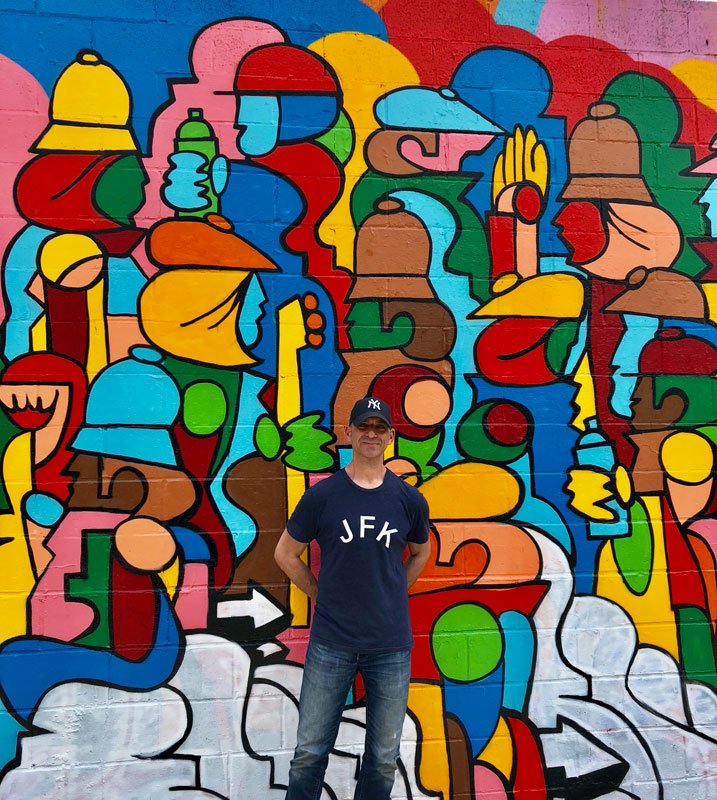
Ryan Seslow with his new mural at the Welling Court Mural Project in Astoria, NY, June 2018. All images and artwork courtesy Ryan Seslow.
CAA member Ryan Seslow is an artist, graphic designer, web designer, illustrator, and a professor of art and design living and working in New York. As a visual artist he works with a synthesis of applied arts, new media, digital and internet art, and as a professor of art and design he’s been teaching various hybrid studio art, digital art, graphic design, digital storytelling, communication technology, and web design courses for graduate and undergraduate level programs between CUNY York College, CUNY BMCC, LIU Post, and Iona College since 2004.
CAA media and content manager Joelle Te Paske corresponded recently with Ryan via email to learn more about what he’s thinking about and working on.
Joelle Te Paske: Thanks so much for taking the time to chat with me. So first things first – where are you from?
Ryan Seslow: I’m from New York, born and raised. My family migrated from Manhattan to Brooklyn and Queens, then to Long Island. My family owned a business and lived in Williamsburg for many years, then moved to Canarsie. I spent most of my childhood there and then worked for the family business for many years before college and grad school.
JTP: You’re an artist, a designer, and a professor. What drew you to the work you do?
RS: I have always been an artist. I knew it by the time I was 3 years of age because I loved to draw. I could do it for hours all by myself. By the time I was 5 years of age I was making friends in school by drawing cartoon portraits of them, it made everyone laugh. I’m also Deaf and hard of hearing, so having a visual language was the overcompensation for not hearing. I loved to learn but it was at first out of visual necessity. This became an unconventional practice and the discovery of the interconnections of all things creative. This is the short answer of course, but I have always believed in the creative human potential and how we have a responsibility to express and share it.
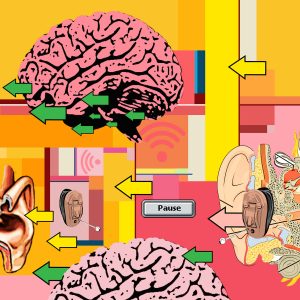 JTP: When did you first become a CAA member?
JTP: When did you first become a CAA member?
RS: CAA was always mentioned and shared by colleagues. I started teaching in 2002 as a graduate assistant in my MFA program so CAA was the go-to resource for finding information on jobs and what teaching artists were doing in the field both after their MFA studies and professionally. I joined in 2002 as a graduate student and then became a member on and off over many years now. I’m guilty of letting memberships lapse in-between but CAA has always been there to welcome me back!
I always wanted to know what other people like myself in the field were doing, how they were doing it, and why? I like to watch things from afar for a while, to understand them and experience them in my own way. This is my learning process. This always leads to ideas on how I can contribute to a larger whole. Sometimes its strangely immediate but it’s usually over time.
JTP: Have you attended CAA conferences?
RS: I haven’t, shame on me! Although I do follow the event, especially since so much of it is accessible online. Many of my teaching colleagues have attended and given presentations over the years in the various cities it takes place. I have always had the vicarious experience of hearing their stories and reading the reflection blog posts. Social media certainly helps this even more now. Perhaps 2019 is my year! Perhaps its time to create a presentation to share my last 14 1/2 years of teaching art and design at the college level from the perspective of a Deaf and Hard of Hearing professor.
JTP: What do you appreciate about being a CAA member? Where would you like to see CAA improve?
RS: I appreciate CAA’s website and the resources that are available there. I appreciate the art journals and other publications, plus the updates that CAA is currently making. I feel that I can reach out to you guys and know that I will get a response, support, and guidance. That’s huge, and I am very grateful for that.
CAA can easily expand upon their presence by collaborating with members in various capacities. I would love to curate an online exhibition on CAA’s website of art history remix GIFs. Or a “pass the buck” internet art collaboration that allows members to contribute and participate and also incorporate their students into the project. Transparency and equality, let’s emphasize this more through community. Art education and the college art education platform is in tremendous flux right now. CAA is in a great position to be a bridge between the institutions, teaching artists and professors, students and the communities they serve, and beyond.
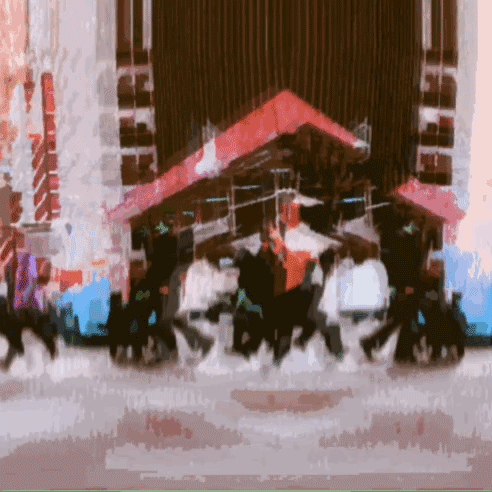
JTP: What’s exciting to you right now in academia?
RS: What excites me most in academia right now is the students, first and foremost and always the students. I love my students and I love re-emphasizing why I am a teaching artist at the college level. I’m there to help create a learning platform both inside and outside of the classroom—instilling skill sets that can be learned, displayed, and applied into the non-static world (meaning NOW, not just when they graduate). This includes public collaborative projects between my campuses and regular use of websites and the internet for dialogue, exhibition, and posterity. The internet and mobile applications make it easy to constantly be an example and share use-value-based content.
I’m excited to see how teaching artists are stepping up to the challenges of a changing academic world. Less and less full-time positions are being created and less people are majoring in various art and design programs. How does this effect both full-time professors and adjuncts? What will this lead to? I’m noticing things—many more integrated and experimental special topics courses are being created to test for interest and collaboration. Companies are partnering with colleges and universities to see “how” they can work together. Good or bad, we shall see, but either way it is a continued time of learning and taking responsibility for solving problems. This forces us to make assessments about how to respond. It is our responsibility to be of service regardless of what gets cut.
JTP: What’s not so exciting in academia?
What is not so exciting, well—the chronic complaining about how things used to be in academia. People need to move on. Chronically complaining about the past and what once was is a waste of energy. The past is the past, nothing is ever static, everything changes—art, artists, art movements, art departments and higher learning institutions. We are always in a state of change and we need to remind each other of this. It is so much easier to operate from the past because it is familiar, but we don’t grow that way.
We need to put more emphasis on the imagination and create potential to generate new solutions. We are always in a position to seek and create new solutions through collaboration and community building. This can also be created outside a single institution. Why not form new relationships and collaboratively solve problems with institutions in other countries, for instance? There is much to learn from contrast. Whether it be social, political, environmental, emotional, or psychological. We need to include and consider others in everything we do.
JTP: I love that you mention the importance of empathy and compassion for the future of education on your website. Can you speak more about that?
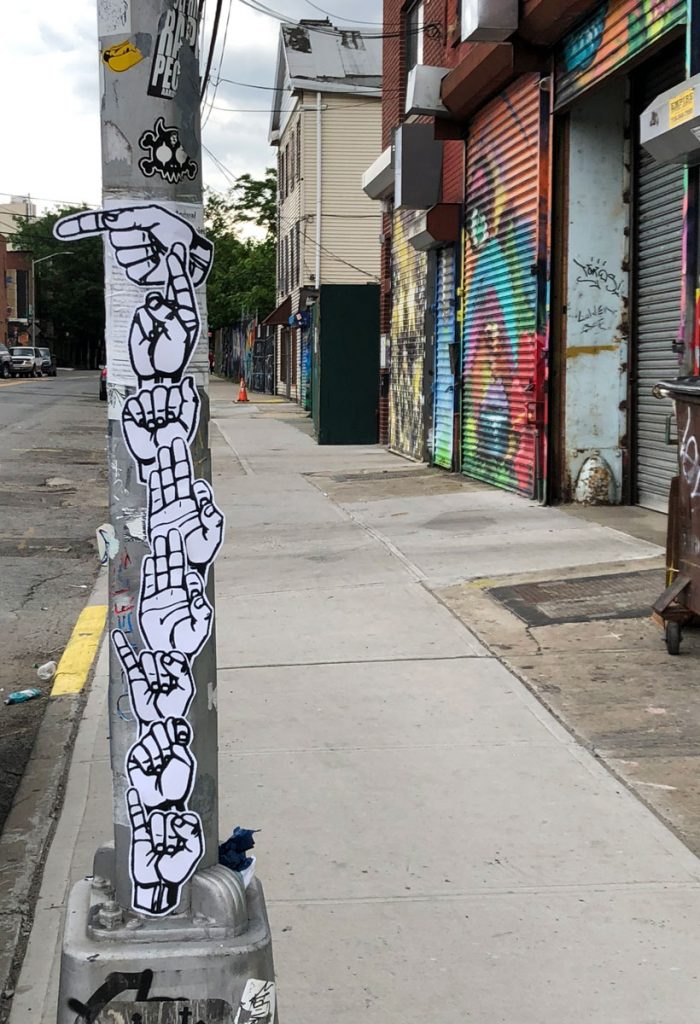
RS: I would be happy to! As I mentioned above, what excites me the most about teaching in higher education (and being a teaching artist in general) is the students. I love people. I’m interested in the psychology of learning and how that simulates itself through art, creativity, and design in a group practice.
Before any new class begins I have the highest level of respect that each student is first and foremost a beautiful human being. Professors are not better or higher than their students. We were all undergraduate students at one point. When I was in undergraduate college, I struggled as a Deaf and Hard of Hearing person attending an all-hearing university. I was afraid to ask my professors to speak louder or more slowly or clearly. Sadly, many of them were standoffish and strict with outdated rules from the 1940s (I was in college in the early 1990s). There was a lack of approachability and human rapport that I later used as the contrast—that was who I would never be. Of course, this was not all of my professors, but there were quite a few.
I set the entire tone and rapport of the 15-week semesters in the first class by meeting my students and learning about each other. The classes are not about me. Before I say one word about the course content and subject, the class meets each other as human beings, they share snippets of their lives, interests, and why they are taking the course. We talk about life, creativity, the imagination’s potential, and how to create a classroom dynamic where we are all collaborators of a whole. This has never once failed and continues to help me learn so much about myself, and the infinite number of ways that others see and experience the world.
In order to be effective teachers we must become masters of communication. This means we must master the art of listening. It’s not simply “hearing” what someone is saying, but learning how to be attuned and aware that listening goes far beyond the functions of the ears. It means being fully present with out the distractions of one’s ego making judgments and counteracting what is being said by the person speaking or communicating. As a Deaf and Hard of Hearing person working mainly in hearing persons environments it has been a very long road for me to learn how to communicate in various ways. The hearing world can learn a lot from the Deaf and Hard of Hearing community on this. I’m currently working on ways to share more about this with my colleagues, students and administrators.
JTP: That’s terrific, thank you. Could you share some of the projects you’re working on now?
RS: Ah, many, many things, here are a few:
1. I have an online exhibition running right now. I created this specifically for my website to show the potential of creating works for the internet first – then see how they can transcend into otherness. (Otherness meaning a non-commissioned public space a gallery or a museum.) I’m doing this because the internet is incredibly accessible, versatile and has so much potential for sharing of art.
This exhibition is titled: Communicating My Deaf & Hard of Hearing Self – Part 1
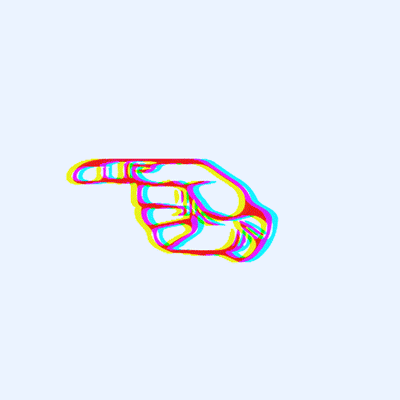
All of the pieces have been created in 2018 and consist of digital illustrations, collage, animated GIFs, video art, and written words. Fragments of manipulated grainy images and re-compositions display the variation and extension of each piece. The works are visual representations for the regular distortions, missing of sounds, words, and overall communication I experience daily. They represent how I feel, react, overcompensate, and adjust to communication in various interactions. They are intended to be both subtle, confusing and difficult to follow. Communicating My Deaf & Hard of Hearing Self – Part 1 is the first installation in the series. It is first published here on my website and shared via my social media platforms. I am seeking to extend this body of work into a lecture series for both the Deaf, Hard of Hearing and the Hearing world.
2. One of my favorite pedagogical models is a class blog. I see a lot of power and potential in it. I teach between two CUNY colleges here in New York and just submitted a wonderful cross-campus class collaboration to the New York Public Library’s zine collection. The students applied their new skill sets by interacting with each other using a class blog via the CUNY Academic Commons (where I’m a sub-committee member). You can view the entire project here.
3. I’m the curator and juror of the Art of the Hills exhibition currently on view at the Berkshire Museum in Pittsfield, MA. You can read my essay on the project here and via the Museum’s website.
4. I have a new mural at the Welling Court Mural Project in Astoria, NY. The image attached to this interview is of me and my completed mural from this past June, 2018. You can read more here.
JTP: What would you like to see more of in the field regarding resources for Deaf and Hard of Hearing professors?
RS: I would very much like CAA’s help. We could create a network and resource for connecting with more Deaf and H of H teaching artists and professors. It would be great to initiate this via this interview and build off of it.
Are you a teaching artist and/or professor who identifies as Deaf or Hard of Hearing? Let us know.
JTP: Who is your favorite artist or designer? Favorite exhibition?
RS: Ah, the hardest of all questions! I’m constantly redefining and integrating new and old favorites across all levels of influence and inspiration. I tend to like various things and discover so much retroactively through continuous research.
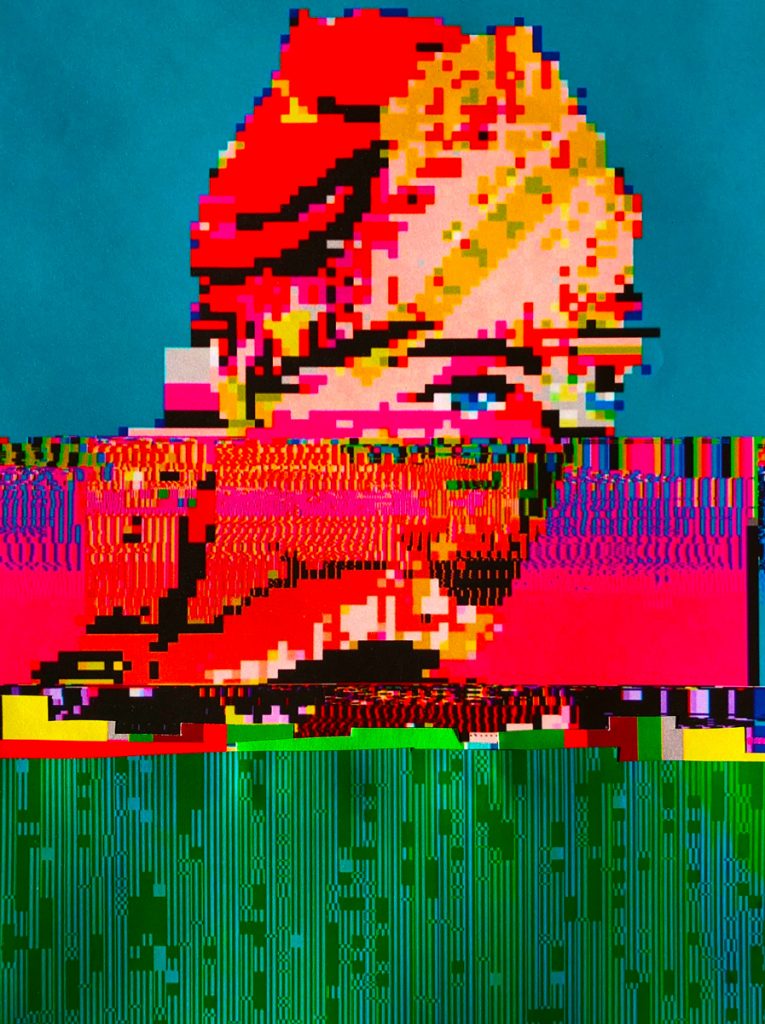
My longest running artistic influence is by far the 1980s New York City subway graffiti movement and many of the artists that pioneered it. Artists like Doze Green, Dondi White, Futura, Lady Pink, John Fekner, and Lee Quinnones are just a few to name. I got into writing graffiti in 1984 and it always stayed with me. I share the history of graffiti in every course I teach.
There is context and influence to be shared across all art and design disciplines. I also love the work of Takashi Murakami, Kara Walker, Cai Guo-Qiang, Yayoi Kusama and Matthew Barney (to name a few). Matthew Barney’s retrospective at the Guggenheim Museum in 2003 was, and still is, one of my favorite exhibitions of all time. I say this because not only did I love the variety of interconnected works in film, photography, sculpture, drawing, and installation, but the museum space itself was incredibly important and complementary to the entire exhibition. I saw the show 8 times in total.
I’m a big Paul Rand fan in the design world, as well as Joshua Davis and Debbie Millman (and her podcast Design Matters).
One of my favorite books is called Viral Art written by the multi-talented author, curator, and critic RJ Rushmore. You can download or read this book online. It’s a fantastic peek into the evolution of how graffiti and street art and their practitioners now use the internet and various web tools as a means of transcending the art form.
JTP: Thanks, Ryan! It’s great to connect with you and learn about your work. Let’s keep building resources.

This interview has been lightly edited for clarity.


